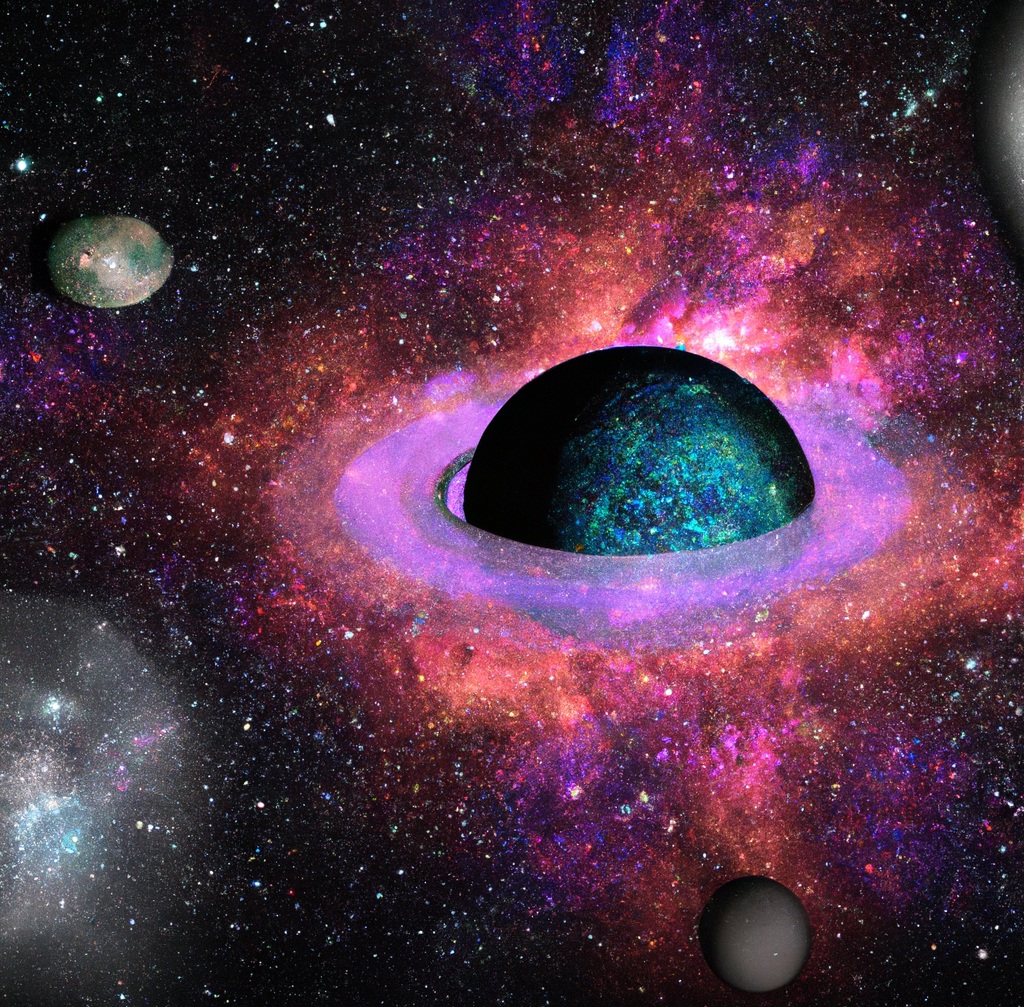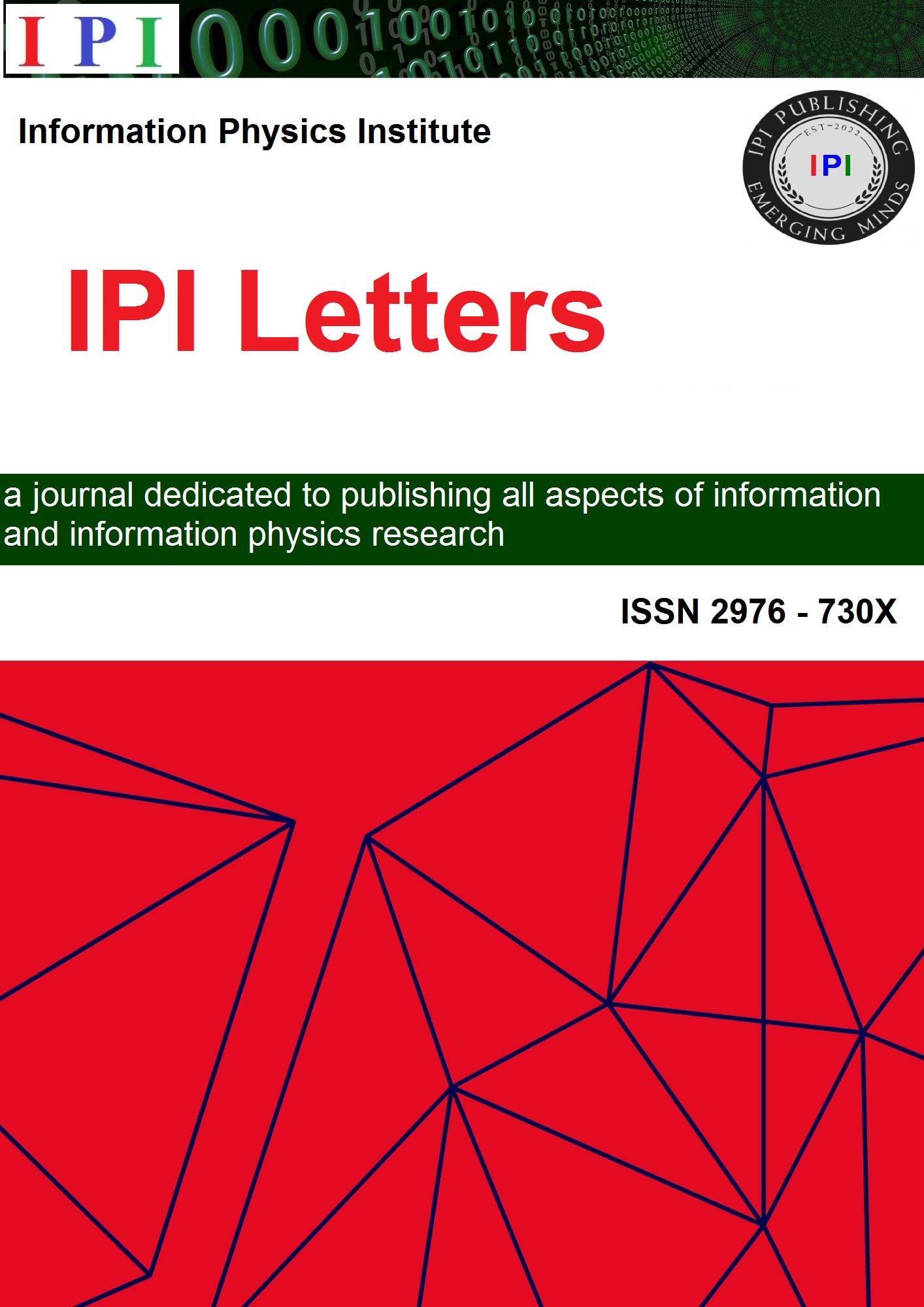Actual Problems of Modern Physics, Astrophysics, and Cosmology
DOI:
https://doi.org/10.59973/ipil.118Keywords:
Keywords: metric tensor, Einstein's GR equation, Hubble constant, fractal structure of the Universe, quantum wave equations of the gravitational field, duality of time, singularity point, Big Bang.Abstract
Variants of solving actual problems of modern physics, astrophysics, and cosmology are considered. Since the observable Universe is a rotating black hole, the Kerr metric is the most optimal for solving Einstein's GR equation. New basic equations of cosmology are proposed, which take into account the effect of space rotation of the observable Universe. The expansion of space in the observable Universe after the Big Bang ended on the surface of the Hubble sphere. The radius of this sphere is half the Schwarzschild radius, so the observable Universe, like the Hubble sphere, is a black hole. The effect of redshift from distant objects of the observable Universe in all azimuths from the observer is associated with the rotation of the Hubble sphere. This means that dark energy does not exist, and the kinetic energy of the Hubble sphere creates the effect of the presence of a dark mass. The gravitational field has two fundamental properties: 1) it curves the space around any gravitating object, and 2) it creates a kinematic gravitational viscosity, which slows down the movement of some parts of matter relative to its other parts. The second property is based on the quantum-wave nature of the gravitational field. The quantum of the gravitational field is the square of the speed of light in a vacuum. The physical nature of the gravitational field quantum is the kinematic gravitational viscosity of the gravitational field of the baryonic matter of the observable Universe. The second property limits the maximum possible transfer rate of the physical interaction. Given both fundamental properties, a complete description of the gravitational field is based on a complex consideration of three equations: 1) Einstein's GR equation, and 2) two quantum-wave Maxwell-like Heaviside equations. The connection between the Standard Model of physics and gravitational interaction is proposed to be established based on the fact that the electromagnetic field is a special case of the gravitational field since the electric charge is a function of the moment of mass, Coulomb's law can be represented in gravitational form, and the basic units of measurement of electromagnetism can be expressed in terms of units of measurement gravity. The Universe has a hierarchical fractal structure. With the growth of the scale factor of the Universe, a fractal inflation of all the main attributes of matter is observed. The scale factor between the microcosm and the macrocosm is proposed to be established based on the modified Dirac Big Numbers. Gravitational-electromagnetic resonance is proposed to be used for accurate estimation of the mass of distant gravitating objects in the observable Universe. Gravitons and WIMPs, as carriers of the gravitational field and dark mass, are absent in nature. The absence of gravitons is due to the absence of mass in the formula for the quantum of the gravitational field. The absence of WIMPs is because the dark mass is determined by the kinetic energy of rotation of the observable Universe.
References
Weinberg, S., 1972, ”Gravitation and Cosmology: Principles and Applications of the General Theory of Relativity”, 695 p (in Russian).
Weinberg, S., 2008, ”Cosmology”, .: URSS, 608 p. ISBN 978-5-397-03648-1 (in Russian).
Zasov, A.V., Postnov, K.A., 2011, ”General Astrophysics”, Moscow State University, Vek 2, 2d Edit., 576 p., ISBN 978-5–85099–188–3 (in Russian).
Zeldovich, Ya.B., Novikov, I.D., 1975, ”Structure and Evolution of the Universe”, M .: Nauka, 736p (in Russian).
Ade, P. A. R.; Aghanim, N.; Armitage-Caplan, C.; et al. Planck Collaboration, 2013, ”Planck 2013 results. I. Overview of products and scientific results – Table 9, 10”. Astronomy and Astrophysics, 571, A1, doi: 10.1051/0004-6361/201321529, arXiv: 1303.5062v2.
Ade, P.A.R., et al. Planck Collaboration, 2015, ”Planck 2015 results. XIII. Cosmological parameters”, Astronomy & Astrophysics. 594: A13, Table 4, doi:10.1051/0004-6361/201525830 DOI: https://doi.org/10.1051/0004-6361/201525830
Aghanim, N., Akrami, Y., Ashdown, M., Aumont, J., Baccigalupi, C., Ballardini, M., Banday, A. J., et al. Planck Collaboration, 2018, ”Planck 2018 results. VI. Cosmological parameters”, Retrieved 18 July 2018, arXiv:1807.06209.
Bucher, P. A. R., et al. Planck Collaboration, 2013, ”Planck 2013 results. I. Overview of products and scientific Results”, Astronomy &Astrophysics, 571: A1. 2013, arXiv:1303.5062. doi:10.1051/0004-6361/201321529. DOI: https://doi.org/10.1051/0004-6361/201321529
Cowen, Ron, Castelvecchi, Davide, 2 December 2014, ”European probe shoots down dark-matter claims”, Nature, doi:10.1038/nature.2014.16462. DOI: https://doi.org/10.1038/nature.2014.16462
European Space Agency, ”Planck Publication: Planck 2015 Results”, February 2015,
https://www.cosmos.esa.int/web/planck/publications.
Grieb, Jan N., S´anchez, Ariel G., Salazar-Albornoz, Salvador, 2016, ”The clustering of galaxies in the completed SDSS-III Baryon Oscillation Spectroscopic Survey: Cosmological implications of the Fourier space wedges of the final sample”, Monthly Notices of the Royal Astronomical Society, 467(2): stw3384, doi:10.1093/mnras/stw3384, arXiv:1607.03143. DOI: https://doi.org/10.1093/mnras/stw3384
Macaulay, E., et al. DES Collaboration, 2018, ”First Cosmological Results using Type Ia Supernovae from the Dark Energy Survey: Measurement of the Hubble Constant”. arXiv:1811.02376.
Riess, Adam G., et al., 2019, “Large Magellanic Cloud Cepheid Standards Provide a 1% Foundation for the Determination of the Hubble Constant and Stronger Evidence for Physics Beyond ΛCDM”, The Astrophysical Journal, Volume 876, Number 1, doi: 10.3847/1538-4357/ab1422, arXiv:1903.07603. DOI: https://doi.org/10.3847/1538-4357/ab1422
Timkov, V.F., Timkov, S.V., Zhukov, V.A., Afanasiev, K.E., 2019, ”Analytical Evaluation of the Numerical Values of the Hubble Constant and Main Spatial-Energy Characteristics of the Observable Universe”, Journal Digital Technologies,v 26, ISSN: 2307-9754, Published by Odessa National Academy of Telecommunications, pp 7 -21, https://ojs.onat.edu.ua/index.php/digitech/issue/view/81, DOI: https://doi.org/10.33243/2313-7010-26-7-21
hal-02045149v3.
Timkov, V.F., Timkov, S.V., 2015, “Rotating Space of the Universe, as the Source of Dark Energy and Dark Matter.”, International Scientific-Technical Magazine: Measuring and Computing Devices in Technological Processes, ISSN 2219-9365, 3 (52), p.p. 200 – 204, http://nbuv.gov.ua/UJRN/vott 2015 3 40, hal-01329145v1.
Lior Shamir, 2020, “Large-scale asymmetry between clockwise and counterclockwise galaxies revisited”, Astronomical Notes, V 341, I 3, pp 324-330, doi: 10.1002/asna.202013745, arXiv: 2004.02960. DOI: https://doi.org/10.1002/asna.202013745
Lior Shamir, 2022, “New evidence and analysis of cosmological-scale asymmetry in galaxy spin directions”, Journal of Astrophysics and Astronomy, 43, 24, doi:10.1007/s12036-022-09809-8, arXiv: 2201.03757. DOI: https://doi.org/10.1007/s12036-022-09809-8
Lior Shamir, 2022, “A possible large-scale alignment of galaxy spin directions -Analysis of 10 datasets from SDSS, Pan-STARRS, and HST”, New Astronomy, V 95, 101819, doi: 10.1016/j.newast.2022.101819, arXiv: 2204.04577. DOI: https://doi.org/10.1016/j.newast.2022.101819
Migkas, K.,Schellenberger,G., Reiprich,T.H., Pacaud,F., Ramos-Ceja M.E.,Lovisari L., 2020,“Probing cosmic isotropy with a new X-ray galaxy cluster sample through the LX–T scaling relation”, A&A, V 636, A 15, doi: 10.1051/0004-6361/201936602, arXiv: 2004.03305. DOI: https://doi.org/10.1051/0004-6361/201936602
Rodrigues, D.C., 2008, “Anisotropic cosmological constant and the CMB quadrupole anomaly”, Physical Review D, 77(2):023534, doi: 10.1103/PhysRevD.77.023534, arXiv: 0708.1168 DOI: https://doi.org/10.1103/PhysRevD.77.023534
Su, S.-C., Chu, M.-C., 2009, “Is the Universe rotating?”, The Astrophysical Journal, 703:354–361, doi: 10.1088/0004-637X/703/1/354, arXiv: 0902.4575. DOI: https://doi.org/10.1088/0004-637X/703/1/354
Timkov, V.F., Timkov, S.V., Zhukov, V.A., Afanasiev, K.E., 2021, “Quantization of the Gravitational Field. Theoretical and Experimental Substantiation of the Gravitational-Electromagnetic Resonance. The Physical Nature of the Quantum of the Gravitational Field. Why the Speed of Light in Vacuum is Constant”, Collection of scientific works of the Odessa Military Academy, ISSN: 2313-7509, V 16, I
, pp 151-180, doi: 10.37129/2313-7509.2021.16.151-180, hal- 02553557. DOI: https://doi.org/10.37129/2313-7509.2021.16.151-180
Schwarzschild, K., 1979, “On the Gravitational Field of a Point Mass in Einstein’s Theory”, Collection of Articles: Albert Einstein and the Theory of Gravity, M.: Mir, p.p. 199-207 (in Russian).
G ¨odel, K., 1949, “An example of a new type of cosmological solution of Einstein’s field equations of gravitation”, Rev. Mod. Phys., Vol. 21, p.p. 447-450, doi:10.1103/RevModPhys.21.447. DOI: https://doi.org/10.1103/RevModPhys.21.447
Marquet Patrick, 2021, “The Exact G ¨odel Metric”, Progress in Physics, V 17, I 2, p.p. 133-138, https://www.ptep-online.com/2022/PP-63-13.PDF.
Kerr, Roy P., 1963, “Gravitational Field of a Spinning Mass as an Example of Algebraically Special Metrics.” Physical Review Letters 11 (5), 237–238, doi:10.1103/PhysRevLett.11.237. DOI: https://doi.org/10.1103/PhysRevLett.11.237
Kerr, Roy P., 2008, “Discovering the Kerr and Kerr–Schild metrics.”, e-Print arXiv:0706.1109.
Christopher M., Hirata, 2012, “Kerr black holes: I. Metric structure and regularity of particle orbits”, Caltech e-Print: http://www.tapir.caltech.edu/∼chirata/ph236/2011-12/lec26.pdf
Herbert Balasin, Herbert Nachbagauer, 1994, Distributional energy-momentum tensor of the Kerr-Newman spacetime family, Class. Quantum Grav V 11, N 6, 1453, doi:10.1088/0264-9381/11/6/010, arXiv: gr-gc/ 9312028. DOI: https://doi.org/10.1088/0264-9381/11/6/010
Weinberg, S.,1989, The Problem of the Cosmological Constant, (Maurice Loeb Lectures on Physics at Harvard University), UFN, T. 158, Is. 8, pp 639-678, In Russian, doi:10.3367/UFNr.0158.198908d.0639. DOI: https://doi.org/10.3367/UFNr.0158.198908d.0639
Hawking, S., 1967, “The occurrence of singularities in cosmology, III. Causality and singularities.”, Proc. Roy. Soc. Lond., A300, 187-201. DOI: https://doi.org/10.1098/rspa.1967.0164
Hawking, S., Penrose, R., 1970, “The singularities of gravitational collapse and cosmology.”, Proc. Roy. Soc. Lond. A. 314, 529-548, https://royalsocietypublishing.org/doi/pdf/10.1098/rspa.1970.0021 DOI: https://doi.org/10.1098/rspa.1970.0021
Hawking, S, George, F. R., Ellis, 1973, The Large Scale Structure of Space-Time, Publisher: Cambridge University Press,Online ISBN: 9780511524646, 391 p., https://doi.org/10.1017/CBO9780511524646 DOI: https://doi.org/10.1017/CBO9780511524646
Hawking, S., 2014, Singularities and the geometry of spacetime, Eur. Phys. J. H, doi: 10.1140/epjh/e2014-50013-6. DOI: https://doi.org/10.1140/epjh/e2014-50013-6
Penrose, R., 1965, Gravitational collapse and space-time singularities, Phys. Rev. Lett. 14. DOI: https://doi.org/10.1103/PhysRevLett.14.57
Timkov, V.F., Timkov, S.V., Zhukov, V.A., Afanasiev, K.E., 2017, Fractal Structure of the Fundamental Constants. Numerical Evaluation of the Values of Some of Fundamental Constants with Use of the Major Characteristics of Muon, International scientific-technical magazine: Measuring and computing devices in technological processes, ISSN 2219-9365, 3 (59), p.p. 188 –193, http://nbuv.gov.ua/UJRN/vott 2017 3 31, hal-01581300v1
Timkov, V.F., Timkov, S.V., Zhukov, V.A., Afanasiev, K.E., 2018, “Fractal Genesis of the Angles of the Neutrino Mixing Matrix”, Herald of Khmelnitsky National University, ISSN 2307-5732, 263(4), p.p. 263 – 272, http://nbuv.gov.ua/UJRN/Vchnu tekh 2018 4 43, hal-01782443
Timkov, V. F., Timkov, S. V., Zhukov, V. A., 2016, “Fractal structure of the Universe.”, International scientific-technical magazine: Measuring and computing devices in technological processes, ISSN 2219-9365, 2 (55), p.p. 190 – 197, http://nbuv.gov.ua/UJRN/vott 2016 2 35, hal-01330337v1
Gurzadyan, V.G., Penrose, R., 2013, “On CCC-predicted concentric low-variance circles in the CMB sky.” Eur. Phys. J. Plus, 128 (2), 22, doi:10.1140/epjp/i2013-13022-4, arXiv:1302.5162. DOI: https://doi.org/10.1140/epjp/i2013-13022-4
Stephen M. Feeney, Matthew C. Johnson, Daniel J. Mortlock, and Hiranya V. Peiris, 2011, First Observational Tests of Eternal Inflation, Phys. Rev. Lett. 107, 071301, https://arxiv.org/abs/1012.1995 DOI: https://doi.org/10.1103/PhysRevLett.107.071301
The Review of Particle Physics, 2023, Summary Tables, Baryons, https://pdg.lbl.gov/2023/tables/contents tables.html
NIST. Fundamental Physical Constants. Complete Listing. 2022 CODATA adjustment.
https://physics.nist.gov/cuu/Constants/Table/allascii.txt
Timkov, V.F., Timkov, S.V., Zhukov, V.A., 2016, “Electric charge as a function of the moment of mass. The gravitational form of Coulomb‘s law.”, International scientific-technical magazine: Measuring and computing devices in technological processes, ISSN 2219-9365, 3 (56), p.p. 27 –32, http://nbuv.gov.ua/UJRN/vott 2016 3 4. , hal-01374611v
Timkov, V.F., Timkov, S.V., Zhukov, V.A., 2015, “Plancks Universal Proportions. Gravitational –Electromagnetic Resonance.”, International Scientific-Technical Magazine: Measuring and Computing Devices in Technological Processes, ISSN 2219-9365, 3 (52), p.p. 7 – 11, http://nbuv.gov.ua/UJRN/vott 2015 3 3, hal-01329094v1
George, F. R., Ellis, 2012, “Spacetime and the passage of times”, University of Cape Town, https://doi.org/10.48550/arXiv.1208.2611
Heaviside, O., 1893, “A gravitational and electromagnetic analogy”, The Electrician, v. 31, Part I p.p. 281–282, Part II p. 359, http://sergf.ru/Heavisid.htm
Clark, S.J., Tucker, R.W., 2000, “Gauge symmetry and gravito-electromagnetism.”, Classical and Quantum Gravity., 17 (19): 4125–4157, arXiv:gr-qc/0003115. DOI: https://doi.org/10.1088/0264-9381/17/19/311
Mashhoon, B., Gronwald, F., Lichtenegger, H.I.M., 2001, “Gravitomagnetism and the Clock Effect.”, Lect.Notes Phys. Lecture Notes in Physics., 562, pp. 83–108, arXiv:gr-qc/9912027. DOI: https://doi.org/10.1007/3-540-40988-2_5
ashhoon, B., 2008, ”Gravitoelectromagnetism: A Brief Review.”, arXiv:gr-qc/0311030
Fedosin, S.G., 2014, “The General Theory of Relativity, Metric Theory of Relativity and Covariant Theory of Gravitation: Axiomatization and Critical Analysis.”, International Journal of Theoretical and Applied Physics (IJTAP), ISSN: 2250–0634, Vol. 4, No. I, pp. 9-26.
Behera, H., Barik, N., 2007, “Attractive Heavicide-Maxwellian (Vector) Gravity from Special Relativity and Quantum Field Theory.”, arXiv 1709.06876v2
GWTC. The Gravitational-wave Transient Catalog (GWTC)., 2020, https://gwosc.org/eventapi/html/GWTC/; https://gwosc.org/eventapi/html/GWTC-3-confident/GW200220 061928/v1/
Dirac P. A. M., 1937, “The Cosmological Constants.”, Nature, Vol. 139, no. 3512, p. 323, doi:10.1038/139323a0. DOI: https://doi.org/10.1038/139323a0
Dirac P. A. M., 1938, “A New Basis for Cosmology.”, Proceedings of the Royal Society of London A, Vol. 165, no. 921, p.p. 199-208, doi:10.1098/rspa.1938.0053. DOI: https://doi.org/10.1098/rspa.1938.0053
Casado, J., 2004, “Connecting Quantum and Cosmic Scales by a Decreasing-Light-Speed Model.”, arXiv: astro-ph/ 0404130.
Digvijay Wadekar, Leander Thiele, Francisco Villaescusa-Navarro, et al., 2022, “Augmenting astrophysical scaling relations with machine learning: Application to reducing the Sunyaev-Zeldovich flux-mass scatter, Proceedings of the National Academy of Sciences, 120 (12) e2202074120, https://doi.org/10.1073/pnas.2202074120 DOI: https://doi.org/10.1073/pnas.2202074120
Timkov, V. F., Timkov, S. V., Zhukov, V. A., 2015, “Gravitational-electromagnetic resonance of the Sun as one of the possible sources of auroral radio emission of the planets in the kilometer range.”, International scientific-technical magazine: Measuring and computing devices in technological processes, ISSN 2219-9365, 4 (53), p.p. 23 – 32, http://nbuv.gov.ua/UJRN/vott 2015 4 4, hal-01232287v1
Timkov, V. F., Timkov, S. V., Zhukov, V. A., 2016b, “Gravitational-electromagnetic resonance of the Sun in the low-frequency of the radio spectrum of the Jupiter.”, International scientific-technical magazine: Measuring and computing devices in technological processes, ISSN 2219-9365, 2 (55), p.p. 198 – 203, http://nbuv.gov.ua/UJRN/vott 2016 2 36, hal-01326265v1

Downloads
Published
How to Cite
Issue
Section
License
Copyright (c) 2024 Valery Timkov

This work is licensed under a Creative Commons Attribution 4.0 International License.














